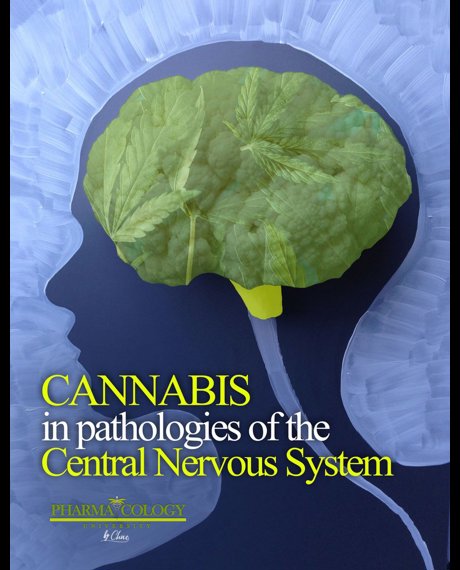Cannabis in Pathologies of the Central Nervous System
Cannabis in Pathologies of the Central Nervous System
€ 9,17
Welcome to explore the wonderful world of cannabis in the pathologies of the central nervous system!
The nervous system is a complex of specialized structures, consisting of the brain, spinal cord, and nerves, which control and regulate the functioning of the various organs and systems, organize their interrelationship, and the relationship of the organism with the external environment.
The basic unit of the nervous system is the nerve cell known as the neuron and its numerous branching fibers called dendrites. The human brain has approximately 100 billion neurons.
There is evidence of cannabinoids' therapeutic applications throughout history. Ancient Chinese culture noted the cannabis plant's benefits for various ailments; centuries later, the Arabs promoted its use in numerous medical treatises. At that time, they had no idea how the plant's substances exerted their effect. But, facts proved significant improvements when treating various symptoms and pathologies. Thanks to the constant advances in contemporary medicine, the mechanisms by which these substances exert their function are increasingly better understood.
Interest in the biological properties of cannabis increased significantly in the early 1990s with the discovery of specific receptors for its components in the Central Nervous System. To this day, cannabinoid receptors are known as CB1 and CB2. They are in the neuronal cell membrane, particularly in the presynaptic terminals, and are part of the family of G-protein-coupled receptors. They are linked to potassium channel activation and calcium channel inhibition.
The endocannabinoid system has a broad action spectrum on neuronal circuits and is involved in numerous physiological processes. So far, they are the only known compounds capable of acting as retrograde messengers at neuronal synapses. They are synthesized by a calcium-dependent mechanism in the postsynaptic terminals, which is capable of diffusing to the presynaptic terminal and inhibiting the release of neurotransmitters. That reinforces the idea that endocannabinoids have a high capacity for interaction with different neurotransmitter systems, excitatory and inhibitory. Therefore, using the system's agonists and antagonists could regulate the symptomatology of many nervous conditions.
This ebook will explore in more detail how cannabinoids may serve as potential neuroprotective agents. Especially in different neurodegenerative diseases such as cerebral ischemia, Alzheimer's, Parkinson's, Huntington's, and ALS. All thanks to their ability to control oxidative stress, inflammation, and excitotoxicity present in them.
Welcome to explore the wonderful world of cannabis in the pathologies of the central nervous system!
The nervous system is a complex of specialized structures, consisting of the brain, spinal cord, and nerves, which control and regulate the functioning of the various organs and systems, organize their interrelationship, and the relationship of the organism with the external environment.
The basic unit of the nervous system is the nerve cell known as the neuron and its numerous branching fibers called dendrites. The human brain has approximately 100 billion neurons.
There is evidence of cannabinoids' therapeutic applications throughout history. Ancient Chinese culture noted the cannabis plant's benefits for various ailments; centuries later, the Arabs promoted its use in numerous medical treatises. At that time, they had no idea how the plant's substances exerted their effect. But, facts proved significant improvements when treating various symptoms and pathologies. Thanks to the constant advances in contemporary medicine, the mechanisms by which these substances exert their function are increasingly better understood.
Interest in the biological properties of cannabis increased significantly in the early 1990s with the discovery of specific receptors for its components in the Central Nervous System. To this day, cannabinoid receptors are known as CB1 and CB2. They are in the neuronal cell membrane, particularly in the presynaptic terminals, and are part of the family of G-protein-coupled receptors. They are linked to potassium channel activation and calcium channel inhibition.
The endocannabinoid system has a broad action spectrum on neuronal circuits and is involved in numerous physiological processes. So far, they are the only known compounds capable of acting as retrograde messengers at neuronal synapses. They are synthesized by a calcium-dependent mechanism in the postsynaptic terminals, which is capable of diffusing to the presynaptic terminal and inhibiting the release of neurotransmitters. That reinforces the idea that endocannabinoids have a high capacity for interaction with different neurotransmitter systems, excitatory and inhibitory. Therefore, using the system's agonists and antagonists could regulate the symptomatology of many nervous conditions.
This ebook will explore in more detail how cannabinoids may serve as potential neuroprotective agents. Especially in different neurodegenerative diseases such as cerebral ischemia, Alzheimer's, Parkinson's, Huntington's, and ALS. All thanks to their ability to control oxidative stress, inflammation, and excitotoxicity present in them.
| Prijs | Verzendkosten | Totaal | |
|---|---|---|---|
€ 9,17 | € 0,00 | € 9,17 |
Alternatieve producten
© 2016 - 2024 aanbiedingchecker


/backgroundcolor(255,255,255)/jpg(90)/fetch/https://media.s-bol.com/YEExVx8P8Zx9/829x1200.jpg)
/backgroundcolor(255,255,255)/jpg(90)/fetch/https://media.s-bol.com/g69G1PEQGRXD/AN6OD6l/788x1200.jpg)
/backgroundcolor(255,255,255)/jpg(90)/fetch/https://media.s-bol.com/V1ERN9vJ2XX/837x1200.jpg)
/backgroundcolor(255,255,255)/jpg(90)/fetch/https://media.s-bol.com/Bxow1ADjnoo/833x1200.jpg)